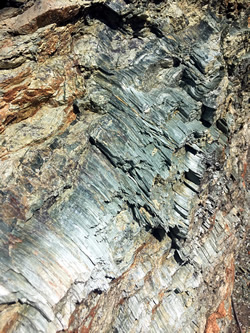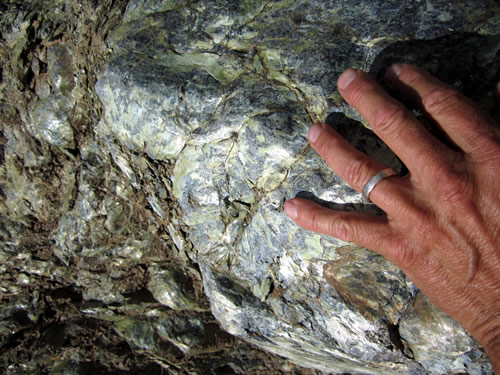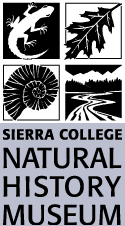Serpentine
Richard P. Hilton and Joe Medeiros
Sierra College

In 1965, California was the first state to adopt an official rock (serpentine) and mineral. The term serpentine describes the mineral but the same word is commonly used for the rock. Rocks containing serpentine minerals are more accurately named serpentinite. Our State Rock is found throughout California and is derived by metamorphic processes involving rocks rich in iron and magnesium. The rocks become altered by heat, pressure and water while buried deep in the Earth’s crust. This process is called serpentinization.
Serpentinite is quite beautiful. It is often a dark green and blue with whitish areas. Smooth shiny surfaces called “slickensides” are formed when individual pieces slide past each other as they are squeezed in fault zones. Movement (slip-sliding) of the more intact pieces have been likened to squeezing a watermelon seed between one’s fingers.
What Makes Up Serpentinite?
There are several minerals that are normally found in the serpentine group. The general formula is X2-3Si2O5(OH)4 but don’t panic! The X-stuff can be magnesium, iron, nickel, aluminum, zinc or manganese. The rest is silica and oxygen, very commonly found elements in Sierran rocks. This simply indicates that serpentinite rocks are dark and filled with heavy/dark minerals as well as silicates (when silica and oxygen combine). Serpentinite is also considered ultramafic (lots of magnesium [Mg] and iron [Fe]), with less than half of the rock made of silicates.
There is a fibrous form of serpentine called chrysotile asbestos that usually forms in cracks of serpentinite. These crystals mostly form at right angles to the crack. In the past, asbestos was often used as insulation and as a fire-resistant material. Asbestos gloves were used to pick up hot or burning materials. We now know that breathing asbestos fibers, especially over a long period of time, may result in the potentially deadly disease asbestosis. Therefore, chrysotile asbestos is listed by the EPA as a carcinogen. Today, asbestos is being carefully and diligently removed from potentially hazardous situations by trained hazmat teams. Some of the asbestos removed is being placed back in the very mines from which it was extracted. The material is then covered so that it will not be picked up by the wind.
The Origin of Serpentinite
Serpentinite is derived from rocks originally found in or below the ocean crust. These dark, iron- and magnesium-rich rocks make up the rock basalt as well as dark crystalline rocks of the upper mantle, the area beneath the crust. Serpentinite is often associated with subduction zones where one piece of earth’s crust slides beneath another. These areas remain as weak areas of the crust and are often associated with fault zones.
There are large bands of serpentinite in California, mainly in the Coast Range, the Sierra foothills and the Klamath Mountains provinces (see link below to a simplified California geologic map). Notice that California serpentinites closely follow fault lines.
Toxic to Plants
The soils that develop on serpentinite are toxic to most plants. Because of high magnesium levels, roots have difficulty obtaining the calcium the plant needs. As noted above, serpentinite has an abundance of other heavy metals like chrome and nickel, which are also toxic to most plants.
Because of the relative lack of vegetation growing on serpentinite areas, this leads to low levels of organic decomposition and therefore soils containing low levels of nitrogen. This is problematic for plants as they require nitrogen for their proteins and nucleic acid construction.
But Some Plants Evolved to Tolerate
Serpentinite soils occupy only about 1% of the land surface of California but contain about 10% of California’s endemic plant species. Endemic species are restricted to certain areas (soils or other physical parameters) and nowhere else. These plants have evolved to tolerate or to live only in these specialized soils. Some of the common species that grow in serpentinite include several shrubby types such as manzanita, chamise, redbud and buck brush. Few oaks grow well in serpentinite; the only oak that thrives in it is the leather oak, but canyon live oak can also be found here.
Only one of California’s many pine species appears to tolerate serpentinite in the Sierra—the foothill pine (also known as gray pine). In southern California, the Coulter pine appears tolerant of ultramafic soils that are toxic to other plants.
Some Wildflowers Like It
Many spring wildflowers appear to tolerate serpentinite. Their minimal requirements for minerals appear to be basically satisfied even by the diminished soils that form from serpentinite. Often, serpentinite soils oxidize a red color due to the iron, causing them to warm sooner and support early spring wildflower shows.
Much of California’s chaparral is underlain by serpentinite. Some areas of serpentinite that are rather crowded with plants are dominated by shrubs and surface wildflower blooms. Other types appear more desert-like with thin, shallow soil and spindly, sparse cover. Passersby often view them as recently-burned landscapes that are attempting to recover. Chaparral can also form where frequent fires suppress the development of forest or woodland ecosystems.
Choose Where You Live
If you love to garden and want lots of vegetables and fruit trees, or don’t want to live in a fault zone, avoid buying a house on serpentinite. But, if you’re there already, there are ways to avoid health hazards and landscape with California native plants that are either serpentinite tolerant or uniquely serpentinite endemics!
The Sierra foothills and the Mother Lode Belt have many serpentinite outcrops. Placer and El Dorado Counties have been dealing with this for many years as homeowners wish to live and build in the foothills. To see how to avoid such soils and potential health risks, we have included links to a report by the Department of Conservation and a map of Placer County below. Similar reports and maps can be obtained for other California counties.

Read More
One of the most interesting aspects of serpentinite in California is the plant-soil (edaphic) connection. While the association between serpentinite soils and plants that are either tolerant of or dependent upon it exists around the world, it is quite important when understanding our state’s flora. For California, Arthur Kruckerberg has written numerous articles and books. His article (California’s Serpentine) in Fremontia is very instructive and his two books, California Serpentines (1985) and Introduction to California Soils and Plants (2006), will take you delightfully deep into this subject.
Go Visit Serpentinite
Don’t be afraid of visiting serpentinite. If you’re not actively stirring up the soil or breathing the dry dust during a windstorm, you’ll be fine. Spring is a wonderful time to go, especially if you want to see wildflower displays and some rare plants.
There are many serpentinite areas throughout California and the simplified CA Geologic Map (link below) will show you generally where they are. In the Sierra, if you simply drive the NW-trending Highway 49, you will see the largest outcrops of serpentinite at Goodyear’s Bar, downstream (west) from Downieville on the North Fork of the Yuba River.
All along Hwy 49 you’ll find outcrops of serpentinite. You’ll note the paucity of lush vegetation or the presence of shrubby chaparral plants dominating with no oaks. If you see pine, it will normally only be the foothill pine. Occasionally you may notice glossy and shiny spots where you might stop to look for pure serpentinite.
More often, in these barren or shrubby spots, you’ll find that the parent rock serpentinite has been weathered into soil by the actions of water, temperature, sunlight, and wind as well as soil organisms (such as bacteria, fungi, algae, lichens) and critters (invertebrates to vertebrates). Serpentinite soils often weather a red color due mostly to the oxidation of iron in the parent rock.
An excellent (and large) area of public land that demonstrates both serpentinite rock and hundreds of acres of serpentinite soils is the Red Hills in Tuolumne County, between Oakdale and Sonora. This is an area of splendid early spring wildflower displays
The Red Hills (BLM) in Tuolumne County, near Chinese Camp and Sonora.
Traverse Creek SIA. Near Georgetown, CA (El Dorado County)
https://www.fs.fed.us/wildflowers/regions/Pacific_Southwest/TraverseCreek/index.shtm
Resources
- California Geologic Map — simplified
- California Native Plant Society – Fremontia
http://www.cnps.org/cnps/publications/fremontia/index.php#issues - California native plants tolerant of serpentinite soils
http://anrcatalog.ucanr.edu/pdf/8400.pdf - Placer County Naturally Occurring Asbestos report
- Serpentine Plant Life in California
http://botanicalgarden.berkeley.edu/wp-content/uploads/2016/05/Newsletter-1993-2.pdf - Kruckeberg, Arthur. California’s Serpentine in Fremontia. January 1984. P11-17. V11 N4.
- Kruckeberg, Arthur. The Flora on California’s Serpentine in Fremontia. April 1984. p. 3-10 V12 N1
- Kruckeberg, Arthur R. California Serpentines: Flora, Vegetation, Geology, Soils, and Management Problems. UC Publications in Botany. Berkeley, CA. 1985
- Kruckeberg, Arthur R. Introduction to California Soils and Plants: Serpentine, Vernal Pools and Other Geobotanical Wonders. UC Press. Natural History Guides. Berkeley, CA. 2006.
- Photos by Joe Medeiros
